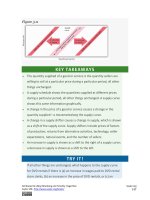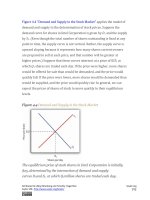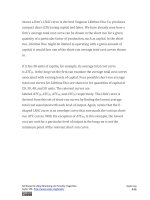Authors libby rittenberg 57
Bạn đang xem bản rút gọn của tài liệu. Xem và tải ngay bản đầy đủ của tài liệu tại đây (412.43 KB, 1 trang )
and services is capital. Capital may thus include physical goods and
intellectual discoveries. Any resource is capital if it satisfies two criteria:
1. The resource must have been produced.
2. The resource can be used to produce other goods and services.
One thing that is not considered capital is money. A firm cannot use money
directly to produce other goods, so money does not satisfy the second
criterion for capital. Firms can, however, use money to acquire capital.
Money is a form of financial capital. Financial capital includes money and
other “paper” assets (such as stocks and bonds) that represent claims on
future payments. These financial assets are not capital, but they can be
used directly or indirectly to purchase factors of production or goods and
services.
Natural Resources
There are two essential characteristics of natural resources. The first is
that they are found in nature—that no human effort has been used to make
or alter them. The second is that they can be used for the production of
goods and services. That requires knowledge; we must know how to use
the things we find in nature before they become resources.
Consider oil. Oil in the ground is a natural resource because it is found (not
manufactured) and can be used to produce goods and services. However,
250 years ago oil was a nuisance, not a natural resource. Pennsylvania
farmers in the eighteenth century who found oil oozing up through their
soil were dismayed, not delighted. No one knew what could be done with
the oil. It was not until the mid-nineteenth century that a method was
Attributed to Libby Rittenberg and Timothy Tregarthen
Saylor URL: />
Saylor.org
57









